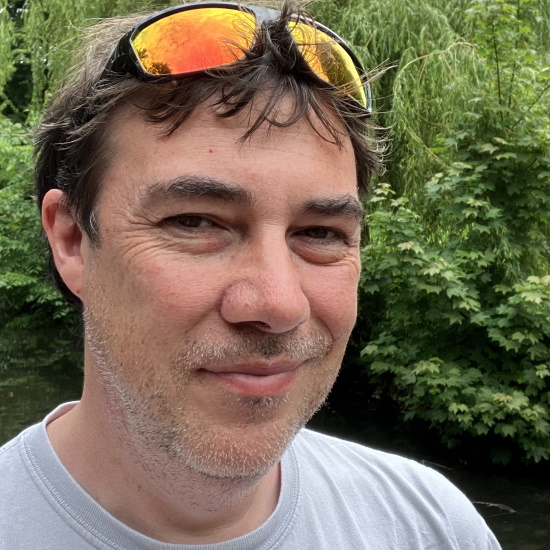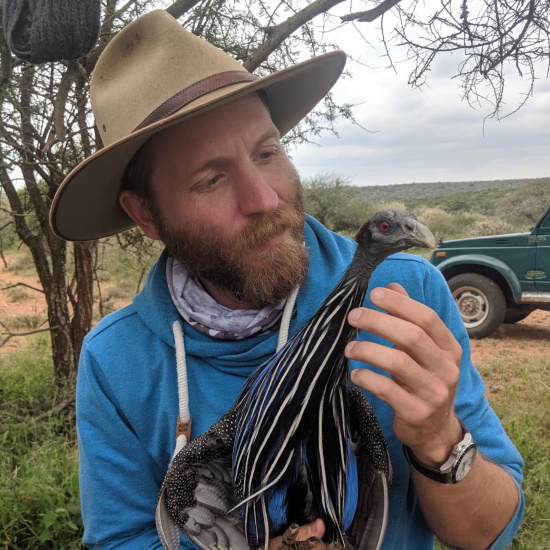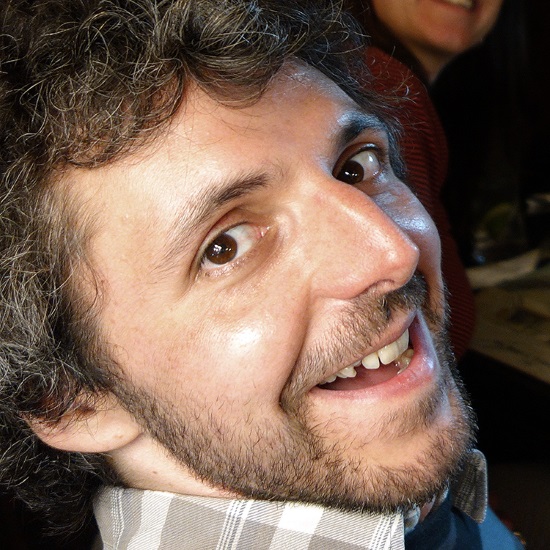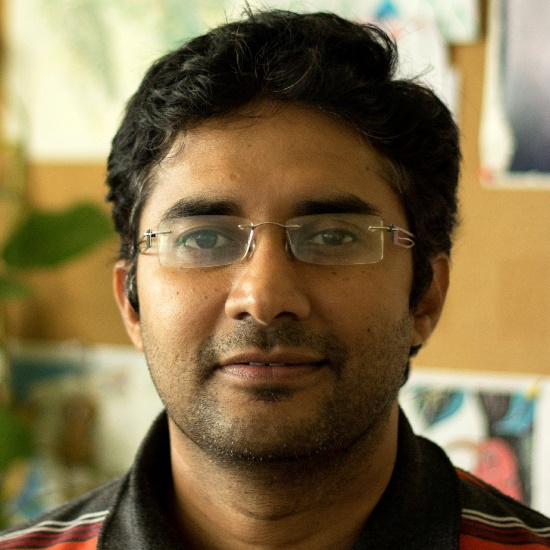Links to external sources may no longer work as intended. The content may not represent the latest thinking in this area or the Society’s current position on the topic.
Collective animal behaviour through time

Scientific discussion meeting organised by Dr Christos Ioannou and Dr Kate Laskowski.
Click watch on YouTube to view the full video playlist.
Great strides have been made in understanding the mechanisms underlying collective behaviour in animals using the complex systems approach common in the physical sciences. This work however focuses on snapshots of collective behaviour. The goal of this meeting was to integrate the study of collective behaviour over time: how does it develop and how does it evolve?
Recordings of the talks will be available soon. An accompanying journal issue has been published in Philosophical Transactions of the Royal Society B.
Attending this event
This meeting has taken place.
Enquiries: contact the Scientific Programmes team
Organisers
Schedule
Chair

Dr Kate Laskowski, The University of California, Davis, USA

Dr Kate Laskowski, The University of California, Davis, USA
Dr Kate Laskowski is interested in investigating how evolution has shaped the developmental processes that generate behavioral individuality. She does this by generating replicate individuals and groups of the naturally clonal fish, the Amazon molly, allowing her to 'replay the developmental clock.' Kate obtained her Bachelor’s of Science at the University of Maryland Baltimore County and her PhD from the University of Illinois where she worked under Alison Bell. She then moved to Germany to work at the Leibniz Institute of Freshwater Ecology & Inland Fisheries before joining the Department of Evolution & Ecology at the University of California Davis in 2019.
| 08:00 - 08:05 | Welcome |
|---|---|
| 08:05 - 08:35 |
Collective behavior through time
Collective behaviours such as flocking in birds or decision making in colonial insects are some of the most intriguing behavioral phenomena in the animal kingdom. This fascination coupled with advancing technologies has allowed scientists to make ever more refined investigations into the mechanisms and functional value of such behaviours. But, as is often the case with behaviour, this work has generally only been able to focus on snapshots of collective behaviour. This static perspective has hindered our ability to focus on other key questions relating to collective behaviour: how does development and natural selection shape the patterns of mechanisms of such fascinating behaviours? Such 'time-depth' perspectives will help offer insight into how responsive collective behaviours may be to external environmental influence throughout animals lives and whether there are certain pathways of evolutionary least resistance in the mechanisms underlying these behaviours. Experimental and analytical methods for studying collective behaviour, the development of behaviour and evolutionary processes are all well established within each of their fields; our goal here is to facilitate the cross-fertilisation of methodologies and ideas for the benefit of both those already working collective behaviour and those who can apply their expertise in development and evolution to novel questions in collective behaviour. 
Dr Kate Laskowski, The University of California, Davis, USA

Dr Kate Laskowski, The University of California, Davis, USADr Kate Laskowski is interested in investigating how evolution has shaped the developmental processes that generate behavioral individuality. She does this by generating replicate individuals and groups of the naturally clonal fish, the Amazon molly, allowing her to 'replay the developmental clock.' Kate obtained her Bachelor’s of Science at the University of Maryland Baltimore County and her PhD from the University of Illinois where she worked under Alison Bell. She then moved to Germany to work at the Leibniz Institute of Freshwater Ecology & Inland Fisheries before joining the Department of Evolution & Ecology at the University of California Davis in 2019. |
| 08:35 - 08:45 | Discussion |
| 08:45 - 09:15 |
Development of collective behaviour in zebrafish

Professor Gonzalo de Polavieja, Champalimaud Foundation, Portugal

Professor Gonzalo de Polavieja, Champalimaud Foundation, PortugalGonzalo is a Senior Principal Investigator at Champalimaud Research, where he leads a team applying mathematics to better understand group behaviour and to develop more formal approaches to learning. He obtained his PhD in Physical Sciences from the University of Oxford, where he studied some aspects of the classical limit of Quantum Mechanics. He switched to Neuroscience as a postdoc in the Laughlin lab (Cambridge University, UK). He then moved to the Department of Theoretical Physics (UAM, Madrid) to build a neurophysiology lab. His team there developed models to understand wiring and neural coding in several species. Also, they built frameworks to study collective behaviour. He moved to Champalimaud Research in 2015 to continue the work in group behaviour, for which his lab has created machine learning tools and models. Since 2017, with Fernando Martin-Maroto, he has been thinking about how to build formal frameworks in which one can study learning in some mathematical detail. |
| 09:15 - 09:25 | Discussion |
| 09:25 - 09:50 | Coffee |
| 09:50 - 10:20 |
Aging in a Social Context
Aging is universal amongst vertebrates. The enhanced experience and physical deterioration that come with age can influence how individuals engage with their social worlds. On the flipside, social processes can themselves influence the pace at which individuals age, ultimately impacting on their longevity and ability to reproduce. Our ability to understand the mechanistic and functional drivers of social behaviour is thus fundamentally tied to our understanding of how social behaviour changes across the lifespan. Using data from a long-term fieldsite of macaque monkeys whose individual survival is linked to their social connections to other members of their group, Dr Brent shows how affiliative social interactions change across adulthood – from prime-aged to older adults. Adult females continue to engage with their social worlds as they age but narrow their networks to have a smaller number of partners. Scaling up to higher-level network properties, Dr Brent tests if network narrowing has knock on effects for how indirectly connected older individuals are compared to their younger counterparts, and whether demographic shifts in the age of group members predicts global network properties, eg, are ‘older’ networks more or less connected compared to ‘younger’ networks. Efforts across taxa to quantify changes in sociality as individuals develop and age will help move us towards a more holistic understanding of the causes and consequences of social behaviours. 
Dr Lauren Brent, University of Exeter, UK

Dr Lauren Brent, University of Exeter, UKLauren Brent is an Associate Professor of Ethology in the Centre for Research in Animal Behaviour at the University of Exeter. Her research asks why social relationships evolved and how they are maintained. Within groups, individuals differ in their tendencies to interact with others and in how deeply embedded they are in their social networks. Across group-living species, the patterning of social interactions and network structures vary. Investigating social variation within groups and across species allows us to determine the mechanisms that drive social relationships, establish their impact on individual health, ageing, life-history, and fitness, and to ultimately draw conclusions about their evolved function. Dr Brent has co-founded two initiatives aimed at open access, collaborative research: the Cayo Biobank Research Unit, and MacaqueNet, which are respectively supported by the National Institutes of Health and a European Research Council Consolidator Grant, FriendOrigins. |
| 10:20 - 10:30 | Discussion |
| 10:30 - 11:00 |
Conformity and copying in group-living animals

Dr Sean Rands , University of Bristol, UK

Dr Sean Rands , University of Bristol, UKSean Rands is a behavioural ecologist, interested in exploring the rules and decision-making processes that organisms use when interacting with each other. Using a broad theoretical and experimental approach, his research team are involved with projects that include exploring the social behaviour of small groups, social defence strategies, parental care behaviour, and pollinator-plant interactions. Sean is a Senior Lecturer at the University of Bristol. |
| 11:00 - 11:10 | Discussion |
Chair

Dr Lauren Brent, University of Exeter, UK

Dr Lauren Brent, University of Exeter, UK
Lauren Brent is an Associate Professor of Ethology in the Centre for Research in Animal Behaviour at the University of Exeter. Her research asks why social relationships evolved and how they are maintained. Within groups, individuals differ in their tendencies to interact with others and in how deeply embedded they are in their social networks. Across group-living species, the patterning of social interactions and network structures vary. Investigating social variation within groups and across species allows us to determine the mechanisms that drive social relationships, establish their impact on individual health, ageing, life-history, and fitness, and to ultimately draw conclusions about their evolved function. Dr Brent has co-founded two initiatives aimed at open access, collaborative research: the Cayo Biobank Research Unit, and MacaqueNet, which are respectively supported by the National Institutes of Health and a European Research Council Consolidator Grant, FriendOrigins.
| 12:10 - 12:40 |
Ontogenesis of self-assembling swarms – building and maintaining collective function in a variable world
Mechanical self-assembly is used by several social insect species to quickly build, out of their own bodies, temporary structures that can serve as shelter, scaffolding, bridges, and even life rafts. For over 50 years, these structures have fascinated naturalists and inspired applications in engineering. Yet, their functional mechanisms and their proximate drivers are still poorly understood. Fortunately, recent technical developments imported from engineering and material sciences have started to uncover the construction principles of these – literally – living architectures. During this talk, Dr Garnier will present recent findings across several social insect species that illustrate the behavioral processes that allow these structures to emerge, develop, adapt, and fade away in response to the needs of the colony and the variable environmental conditions they are subjected to. Dr Garnier will also discuss how these results fit into our general understanding of biological self-assembly, for instance in embryology, and how they can impact areas in engineering interested in the design of complex systems for hard-to-predict and noisy environments. 
Dr Simon Garnier, New Jersey Institute of Technology, USA

Dr Simon Garnier, New Jersey Institute of Technology, USASimon Garnier is an Associate Professor in the Federated Department of Biology at the New Jersey Institute of Technology (NJIT). He is the head of the Swarm Lab, an interdisciplinary research lab that studies the mechanisms underlying Collective Behaviors and Swarm Intelligence in natural and artificial systems. His research aims to reveal the detailed functioning of collective intelligence in systems as diverse as ant colonies, human crowds, or robotic swarms. The Swarm Lab focuses in particular on the mechanisms of information transfer and integration in large groups that can lead to adaptive (or 'intelligent') collective responses to environmental challenges. |
|---|---|
| 12:40 - 12:50 | Discussion |
| 12:50 - 13:20 |
The ecology of collective behaviour: studying groups through time
Collective behaviour is, fundamentally, a response to ecological drivers. For example, animals might be more coordinated and cohesive in their movements when predation risk is higher. However, how animals collectives respond to ecological challenges is likely to reflect not only current conditions, but also individuals' prior experiences. At present, the relative contributions of different temporal processes—individual development, changes in the social environment, and changes in ecological conditions-contribute to the expression of collective behaviours is largely unexplored. One reason is that studies face significant challenges arising from mismatching timescales, where processes such as demographic change take places on completely different timescales to the collective behaviours that they affect. Dr Farine will discuss examples of mismatching timescales, explain the methodological challenges that these raise, and illustrate the conceptual challenges arising from mismatching timescales by drawing from data on wild vulturine guineafowl. By explicitly tackling the challenge of mismatching timescales, Dr Farine hopes to provide some foundations for studying collective behaviour through the lens of development and evolution. 
Dr Damien Farine, University of Zurich, Switzerland

Dr Damien Farine, University of Zurich, SwitzerlandDamien Farine received his DPhil from the University of Oxford in 2014. He subsequently held postdoctoral positions working on birds at Oxford and on baboons at UC Davis. He was then appointed as a principal investigator at the Max Planck Institute of Animal Behavior, before becoming a group leader at the University of Zurich and the Australian National University. His group is focused on studying how social behaviour shapes how individuals interact with their environment. |
| 13:20 - 13:30 | Discussion |
| 13:30 - 13:55 | Tea |
| 13:55 - 14:25 |
Genotypic Variation in Social Groups Shapes Variation in and Selection on Social Group Structure
The structure of individuals’ social groups can be an important driver of variation in components of individuals’ fitness. Yet processes that drive variation in social group structure and its impact on fitness -ie, social selection- are not well- described. The genotypic composition of social groups and how it affects individuals’ fitness -ie, indirect genetic effects (IGEs)- is thought to be an important driver of variation in social selection; subsequently, studying the quantitative genetic basis of social group structure and its effects on fitness is necessary for understanding how groups both generate and respond to social selection. Two ways that the genotypic composition of social groups and IGEs can impact social selection is via frequency-dependent selection, and selection on individuals’ direct and indirect social interactions (ie, social network position). Using replicate genotypes of Drosophila melanogaster flies, the researchers manipulated the genotypic composition of social groups, and measured social network positions and multiple components of fitness for individuals within these groups. They found positive frequency-dependent selection operating on measures of females’ fitness, and this frequency-dependent selection varied with indirect genetic effects of social groupmates. Additionally, they found selection operating on measures of individuals’ social network positions, and this selection also varied depending on indirect genetic effects. These findings suggest variation in social selection can be driven by variation in the social context individuals experience. Because social context has a quantitative genetic basis, these findings also suggest social context-dependent social selection provides a mechanism for the adaptive maintenance of social group structure. 
Dr Eric Wice, Rice University, USA

Dr Eric Wice, Rice University, USADr Eric Wice completed a BS in Biology from the University of Virginia in 2013, and a PhD in Ecology and Evolutionary Biology from Rice University in 2021. Dr Wice’s research bridges the fields of quantitative genetics and behavioural ecology to address questions surrounding how sociality and the structure of social groups form and evolve. Dr Wice has trained and mentored over two dozen students, and Dr Wice is devoted to making science accessible and inclusive to students of diverse racial, ethnic, gender, and socioeconomic identities and backgrounds. Dr Wice will be moving to Nashville, TN, USA in 2022, and they are currently seeking academic postdoctoral positions. |
| 14:25 - 14:35 | Discussion |
| 14:35 - 15:05 |
Dynamics of collective behaviour across space, time, and species
Studies of collective animal behaviour have often ignored individual variability. However, newer individual-based models, together with emerging empirical data on animal groups, emphasise how and why this individual variation (within-group heterogeneity) can be important. Here, Dr King briefly reviews empirical evidence showing the importance of individual variation for the structure and function of collective animal behaviour, with examples from laboratory, free-ranging, and wild animal study systems (eg, fish, sheep, goats, baboons). He will then present ongoing work attempting to quantify and model within-group heterogeneity (across space, time, and species) and its influences on the collective properties of a group. The researchers’ goal is to improve our understanding of how within-group heterogeneity may modify and improve collective behaviour in real animal groups, with a view to engineering better artificial swarm systems, which, like early models of collective behaviour tend to be decentralised, distributed, and homogenous. 
Dr Andrew King, Swansea University, UK

Dr Andrew King, Swansea University, UKDr Andrew King is Associate Professor at Swansea University, UK. He has previously worked at The Zoological Society of London, University College London, The Royal Veterinary College, and the University of Cambridge in the UK, and has held visiting positions in Germany (MPI for Human Development), South Africa (University of Cape Town) and Australia (University of Sydney). His research group study animal social behaviour in a range of animal systems but some favourites are fish, sheep, and baboons. His research has strong applied themes, and he works across disciplines and sectors to apply behavioural studies to topics ranging from wildlife management to swarm robotics. |
| 15:05 - 15:15 | Discussion |
| 15:15 - 15:30 | Panel discussion/Overview (future directions) |
| 15:30 - 17:15 | Poster session |
Chair

Dr Richard Mann, Leeds University, UK

Dr Richard Mann, Leeds University, UK
Richard Mann is an Associate Professor of Statistics in the School of Mathematics at the University of Leeds, and a UK Research and Innovation Future Leaders Fellow. His research focuses on collective behaviour in humans and animals, and in particular the adaptive function of social interactions and social learning, including the role of incentives in optimising collective behaviour. He also studies statistical models of macroevolution and the effect of selection biases in palaeobiology.
| 08:00 - 08:30 |
Collective learning: from collective intelligence to cultural evolution
Collective cognition – where interactions between individuals allow groups to function as integrated sensory, information-processing and decision-making units with superior powers compared to individuals – is one of the key advantages of sociality. However, to what extent collectives as a whole are able to exhibit a ubiquitous individual cognitive capacity – learning – is still relatively poorly understood. Nonetheless, burgeoning evidence from several species now suggests that groups are indeed capable of learning from collective experiences and thus of enhancing their performance beyond the bounds of individual maxima. This process can even give rise to the cultural accumulation of increasingly better solutions to problems repeatedly encountered by a given group, even in the face of turnovers in membership. In this talk, the researchers develop a framework for exploring the mechanisms underlying such collective learning, arguing that while it incorporates elements of both individual and social learning, its drivers extend beyond these. They propose three non-mutually-exclusive mechanisms (individual, empathetic, and organisational learning), the latter two of which represent emergent properties of groups. They look for empirical evidence for each type of learning in their model system (the development of travel routes in homing pigeon flocks), and discuss how the ecology, social organisation and life-history of different species might shape which type of collective learning and cultural accumulation they may expect to find manifested during collective problem-solving specific to their needs. 
Professor Dora Biro, University of Oxford, UK and University of Rochester, USA

Professor Dora Biro, University of Oxford, UK and University of Rochester, USADora Biro received her PhD in Zoology from the University of Oxford. She subsequently held a JSPS postdoctoral research fellowship and a visiting professorship at the Primate Research Institute of Kyoto University, Japan, before returning to Oxford as a Royal Society University Research Fellow in 2007. She was appointed Associate Professor at the Department of Zoology and Tutorial Fellow of St Hugh’s College, University of Oxford in 2013, and Professor of Animal Behaviour in 2019. She is currently Professor of Brain and Cognitive Sciences at the University of Rochester, USA. Her research interests are centred on animal cognition, particularly in the contexts of navigation, tool use, culture and collective decision-making |
|---|---|
| 08:30 - 08:40 | Discussion |
| 08:40 - 09:10 |
Universal geometric principles of decision-making in neural collectives, individuals and animal groups

Professor Iain Couzin, Max Planck Institute of Animal Behavior, Germany

Professor Iain Couzin, Max Planck Institute of Animal Behavior, GermanyIain Couzin is Director of the Max Planck Institute of Animal Behavior and the German Research Foundation Cluster of Excellence 'Centre for the Advanced Study of Collective Behaviour' at the University of Konstanz, Germany. Previously he was a full Professor in Ecology and Evolutionary Biology at Princeton University. His work aims to reveal the fundamental principles that underlie evolved collective behaviour, and consequently includes the study of a wide range of biological systems, from neural collectives to insect swarms, fish schools and primate groups. In recognition of his research he has been recipient of the Searle Scholar Award in 2008, Popular Science’s 'Brilliant 10' Award in 2010, National Geographic Emerging Explorer Award in 2012, the Scientific Medal of the Zoological Society of London in 2013, a Web of Science Global Highly Cited Researcher since 2018, the Lagrange Prize in 2019, and the Leibniz Prize, Germany’s highest research honour, in 2022. |
| 09:10 - 09:20 | Discussion |
| 09:20 - 09:55 | Coffee |
| 09:55 - 10:25 |
The evolution and emergence of intergroup cooperation

Dr Elva Robinson, University of York, UK

Dr Elva Robinson, University of York, UKElva Robinson studies the organisation of social insect societies, combining empirical and modelling work to identify the simple rules followed by individual members of a colony, and to determine how they interact to produce adaptive group-level behaviours. Elva began working in this area with an interdisciplinary PhD at the University of Sheffield. Her post-doctoral work at the University of Bristol involved pioneering a new technique for studying ants: using tiny radio-tags to monitor and manipulate individual ants’ access to information. She moved to the University of York on a Royal Society Dorothy Hodgkin Fellowship in the York Centre for Complex Systems Analysis and is now a Senior Lecturer in Ecology in the Department of Biology. Her current research spans from models and controlled laboratory experiments advancing the theoretical understanding of the organisation of social behaviour, through to ecological fieldwork investigating the adaptive significance and applied consequences of sociality in insects. |
| 10:25 - 10:35 | Discussion |
| 10:35 - 11:05 |
Towards an evolutionary theory of collective behaviour
Collective behaviour is a subfield of behavioural ecology, making extensive use of its tools of observation, experimental manipulation, and model building. However a fundamental behavioural ecology approach, the application of optimality theory, has been comparatively neglected in collective behaviour. This talk seeks to address this imbalance, by outlining an evolutionary theory framework for the discipline. The application of optimality theory to collective behaviour requires a number of questions to be addressed: First, what is the correct quantity to optimise? This is achieved via a combination of considering the organisms' life history, alongside tools such as statistical decision theory and stochastic dynamic programming. Second, what mechanism is appropriate for optimal behaviour? This involves ensuring that models are self-consistent rather than containing arbitrary assumptions. Third, at what level of selection does optimisation act? Selection acts at the level of individuals except in very particular circumstances, yet collective behaviour phenomena are group-level, thus introducing a risk of confusing at what level adaptive properties emerge. This talk presents examples under each of the three questions, as well as discussing mismatches between theory and observation. In doing so, it is hoped that collective behaviour fully inherits the tools and philosophy of its parent discipline of behavioural ecology. 
Professor James Marshall, Opteran Technologies and The University of Sheffield, UK

Professor James Marshall, Opteran Technologies and The University of Sheffield, UKJames Marshall is Professor of Theoretical and Computational Biology at the University of Sheffield, and Chief Science Officer at Opteran Technologies. His interests span collective behaviour, evolutionary theory, and decision theory. Recently he has moved towards using robots as a testbed for the models he works on, and in 2020 co-founded Opteran as a spinout from the University of Sheffield, to develop a new approach for robot autonomy based on reverse-engineering insect brains. |
| 11:05 - 11:15 | Discussion |
Chair

Dr Christos Ioannou, University of Bristol, UK

Dr Christos Ioannou, University of Bristol, UK
Since first studying animal behaviour Dr Ioannou has been interested in the evolution of group living and how groups form and are maintained over short time scales. These interests were further shaped by their PhD with Professor Jens Krause at the University of Leeds and a postdoc with Professor Iain Couzin at Princeton University. Dr Ioannou is now an Associate Professor (Reader) in Behavioural Ecology at the University of Bristol. Their research has covered multiple aspects of group living, particularly the interaction between the behaviour of predators and social interactions in prey, and how inter-individual differences in groups interacts with group decision making. More recently, their research includes how predator and collective behaviour is affected by anthropogenic change in environmental variables, such as turbidity and anthropogenic noise. They use fish as a model system, both in the laboratory and in the field.

Dr Sean Rands , University of Bristol, UK

Dr Sean Rands , University of Bristol, UK
Sean Rands is a behavioural ecologist, interested in exploring the rules and decision-making processes that organisms use when interacting with each other. Using a broad theoretical and experimental approach, his research team are involved with projects that include exploring the social behaviour of small groups, social defence strategies, parental care behaviour, and pollinator-plant interactions. Sean is a Senior Lecturer at the University of Bristol.
| 12:15 - 12:45 |
Lekking as collective behaviour
Lekking is a spectacular mating system in which males maintain tightly organised clustering of tiny territories during the mating season, and females visit these leks for mating. This mating strategy is likely a costly behaviour that requires males engage in exaggerated displays and compete vigorously to maintain their territories as well as to gain matings. Various hypotheses – ranging from predation dilution to mating benefit – offer potential explanations for the evolution of this peculiar mating strategy. However, many of these classic hypotheses rarely consider the spatial dynamics that produce and maintain the lek. In this manuscript, the researchers propose to view lekking through the perspective of spatial ecology and collective behaviour, in which simple local interactions between organisms as well as habitat likely produce and maintain leks. Such local interactions are likely shaped by the interplay of selection pressures, such as predation, mate-competition and mate choice, on both males and females. To test these ideas at both proximate and ultimate levels, the researchers argue that the concepts and tools from the literature of collective animal behaviour, such as high-resolution video tracking that enables capturing fine-scale spatiotemporal interactions, could be useful. They illustrate the promise of this approach using blackbuck (Antilope cervicapra) leks as a case study. Broadly, they argue that a lens of spatial ecology and collective behaviour can provide novel insights into understanding both the proximate and ultimate factors that shape leks. 
Dr Vishwesha Guttal, Indian Institute of Science, India

Dr Vishwesha Guttal, Indian Institute of Science, IndiaVishwesha (Vishu) Guttal is fascinated by the patterns and functions of self-organisation in the biological world. He did his PhD in Physics with Jayaprakash (at The Ohio State University, USA), working on applying tools of physics to ecosystem self-organisation. He did his postdoc with Iain Couzin at Princeton University, working on the evolution of collective motion in animal groups. Vishu is currently an Associate Professor at the Centre for Ecological Sciences at the Indian Institute of Science where he and his lab members use theory, computation, experiments and field work to understand patterns and functions of collective motion and more broadly self-organising ecosystems. |
|---|---|
| 12:45 - 12:55 | Discussion |
| 12:55 - 13:25 |
Collective Anti-Predator Behaviour
The collective behaviour of animals has attracted considerable attention in recent years, with many studies exploring how local interactions between individuals can give rise to global group properties. The functional aspects of collective behaviour are less well studied, especially in the field and relatively few studies have investigated the adaptive benefits of collective behaviour in situations where prey are attacked by predators. This paucity of studies is unsurprising because predator-prey interactions in the field are difficult to observe. Furthermore, the focus in recent studies on predator-prey interactions has been on the collective behaviour of the prey rather than on the behaviour of the predator. Here the researchers present a field study that investigated the anti-predator benefits of waves produced by fish at the water surface when diving down collectively in response to attacks of avian predators. Fish engaged in surface waves that were highly conspicuous, repetitive, and rhythmic involving many thousands of individuals for up to 2 min. Experimentally induced fish waves doubled the time birds waited until their next attack, therefore substantially reducing attack frequency. In one avian predator, capture probability, too, decreased with wave number and birds switched perches in response to wave displays more often than in control treatments, suggesting that they directed their attacks elsewhere. Taken together, these results support an antipredator function of fish waves. The attack delay could be a result of a confusion effect or a consequence of waves acting as a perception advertisement, which requires further exploration. 
Professor Jens Krause, Leibniz Institute of Freshwater Ecology and Inland Fisheries, Germany

Professor Jens Krause, Leibniz Institute of Freshwater Ecology and Inland Fisheries, GermanyJens Krause is a behavioural ecologist with a strong interest in collective behaviour and social networks. He has published a number of books (Living in Groups, OUP; Fish Cognition and Behavior, Wiley/Blackwells; Exploring Animal Social Networks, PUP; Animal Social Networks, OUP) and articles on the mechanisms and functions of living in groups. He is currently Professor for Fish Biology and Ecology in the Faculty of Life Science at the Humboldt University Berlin, Head of Department at the Leibniz-Institute of Freshwater Ecology and Inland Fisheries and on the executive board of the excellence cluster 'Science of intelligence'. He started his university education at the Free University Berlin and obtained his PhD from St John’s College Cambridge, UK, followed by postdocs at Mount Allison University, Canada, and Princeton University, USA, and held a Professorship for behavioural ecology at Leeds University, UK, for several years before moving back to Berlin in 2009. |
| 13:25 - 13:35 | Discussion |
| 13:35 - 14:00 | Tea |
| 14:00 - 14:30 |
Integrative biology of collective behaviour in social caterpillars
Collective behaviour forms the basis for many diverse and complex anti-predator strategies. To evolve, and remain adaptive, these behaviours must depend on their positive impact on individual fitness in the ecological and social context of an individual’s environment, as well at their internal motivational state. Like any behaviour, collective movement or decision making depends on the integration of multiple sensory inputs, and the neural pathways that link the internal and external environment and produce the coordinated response. A coherent understanding of how these processes are coordinated therefore requires and integrative approach that spans traditional disciplines in behavioural biology. Here, the researchers argue that Lepidopteran larvae are well placed to serve as model systems for understanding the integrative biology of collective behaviour. Lepidopteran larvae display striking diversity in social behaviour, the repeated convergent evolution of collective behaviour, and illustrate critical interactions between ecological, morphological and behavioural traits. While previous, sometimes classic, work has provided an understanding of how and why social behaviours have evolved in Lepidoptera, little is known about the developmental and mechanistic basis of these traits. Recent advances in the quantification of behaviour, and the availability of genomic resources and manipulative tools, allied with the exploitation of the behavioural diversity of tractable Lepidopteran clades, will change this. In doing so, the researchers will be able to address previously unapproachable questions such as: How is age dependent plasticity in collective behaviour facilitated by developing neural systems, and why does it evolve? Are similar neural pathways implicated in the convergent evolution of collective behaviour? To what extent is this convergence shaped by the wider sensory and host plant ecology and evolutionary history of a lineage? And how easy is it for selection to modify neural pathways to switch behavioural strategies from individualist to collectivist? 
Dr Stephen Montgomery, University of Bristol, UK

Dr Stephen Montgomery, University of Bristol, UKDr Montgomery's primary interests are focused around how brains and behaviour evolve. He did his PhD on primate brain evolution with Dr Nick Mundy, at the University of Cambridge, and then held a series of fellowships at Oxford and UCL, with Professor Judith Mank, before returning to Cambridge to establish his own group. He is currently a Senior Research Fellow, funded by a NERC Fellowship and an ERC Starter Grant, and Proleptic Senior Lecturer at the School of Biological Sciences, University of Bristol. His group is interested in how brains adapt to different environments, how changes in brain structure produce behavioural differences, and how selection navigates developmental and functional constraints that may limit or channel the adaptive response. They take a comparative approach to tackling these questions, comparing molecular and phenotypic data across species. |
| 14:30 - 14:40 | Discussion |
| 14:40 - 15:10 |
Patterns and processes across the major transition to superorganismality

Professor Seirian Sumner, University College London, UK

Professor Seirian Sumner, University College London, UKSeirian is a Professor of Behavioural Ecology at University College London. She studies social insects to understand their behaviour, ecology, evolution and role in ecosystems. She is especially interested in wasps, and how these insects can reveal the mechanisms and evolution of cooperation. She is also passionate about improving the public image of wasps, and in promoting our understanding of the important role they play in the environment. As part of these efforts, she co-founded the Big Wasp Survey in 2017 – a citizen science project to engage the public with social wasps in their back yard. She also promotes diversity among researchers in academia through Soapbox Science, which she cofounded in 2011. |
| 15:10 - 15:20 | Discussion |
| 15:20 - 16:00 | Panel discussion/Overview (future directions |
